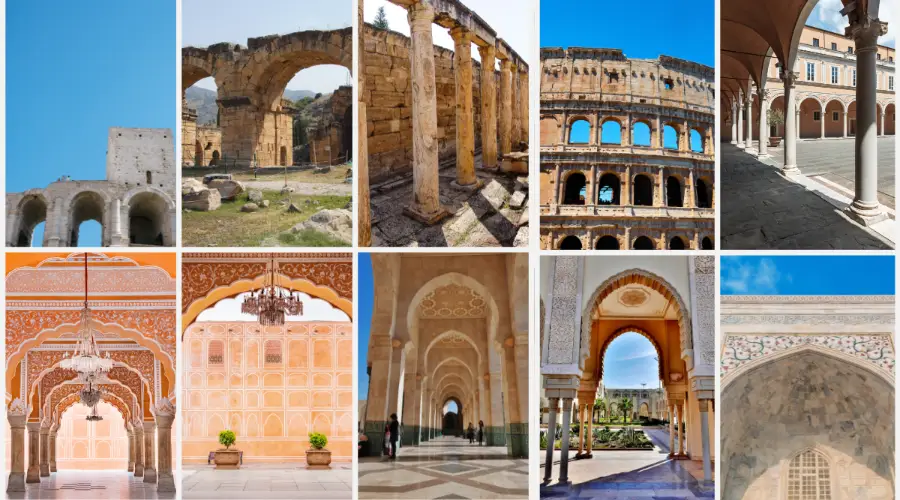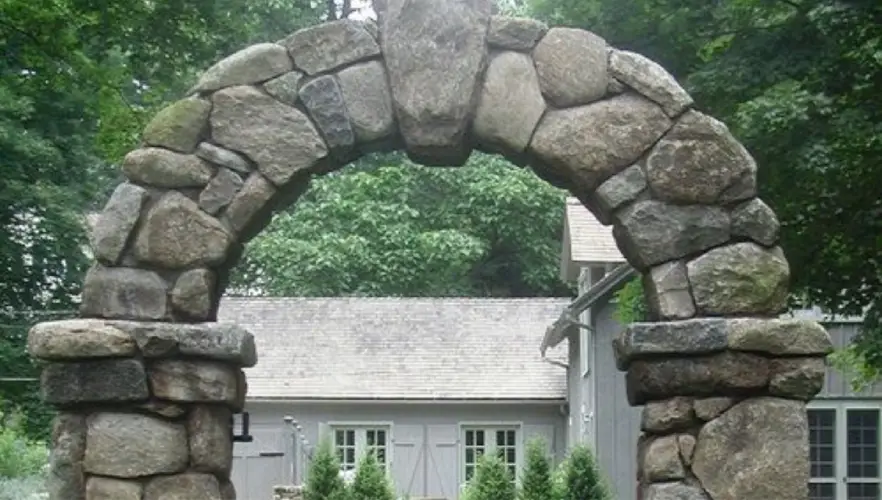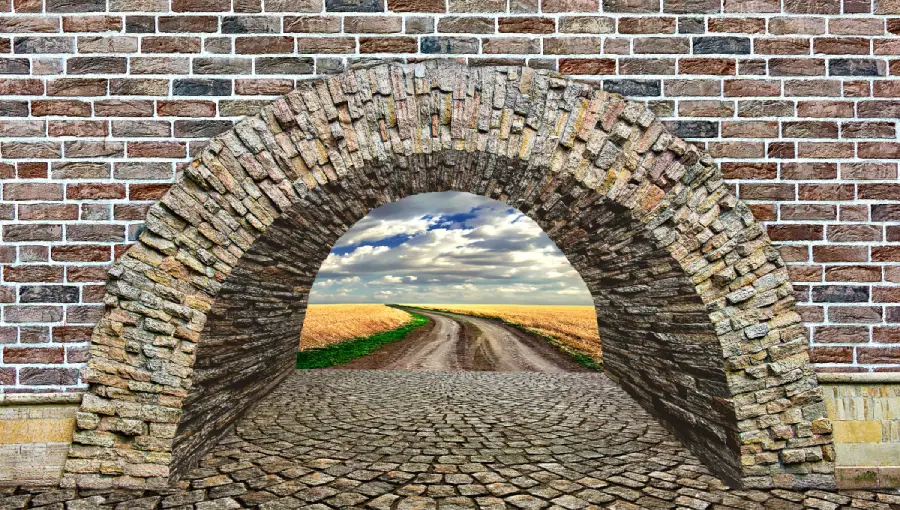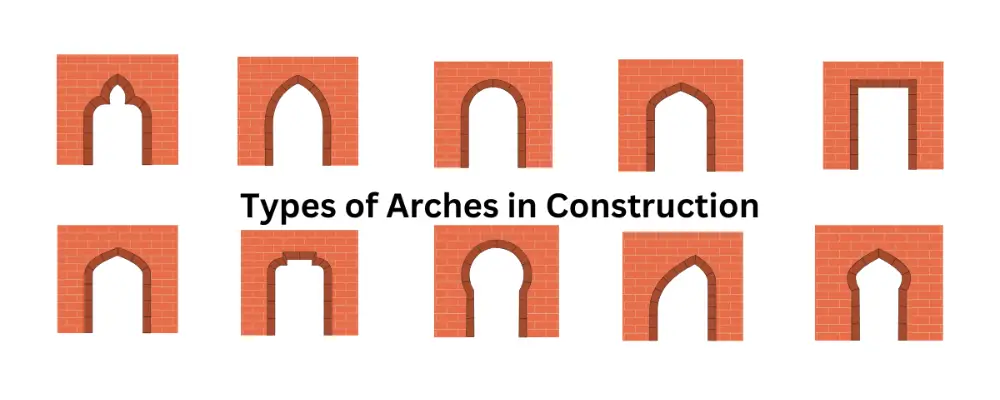An arch is a curved vertical structure with a raised space that may or may not support the weight above it. Arches have been used in construction for hundreds of years for architectural purposes. They are widely used in bridges, doorways, windows and aqueducts. They can carry heavy compressive loads by uniformly distributing the weights above them. There are various types of arches in construction based on the shape, materials used and the number of centres. This blog discusses the different types of arches in the construction field.
Types of Arches in Construction

According to the shape
Based on the shape, arches are classified into:
Pointed Arch
Pointed Arch is an arch where two arcs are sectors of circles that meet at the apex, forming a triangle (irrespective of what triangle is formed). These bricks are also called Gothic Arches. These arches are widely used in cathedrals and castles as visually pleasing element. These arches allow higher walls and oversized windows and help distribute the weight uniformly and more effectively. These arches are ideal for larger structures.
Horseshoe Arch
As the name suggests, the horseshoe arch is in the shape and structure of a horseshoe. It has a unique extended curve structure that extends beyond the semicircle. It brings more architectural and cultural significance and is widely used for doorways and windows in Islamic architecture.
Flat Arch
A flat arch forms an equilateral triangle within the intrados of the structure, formed by the horizontal angle of 60° by skew backs. Although the intrados are flat, a slight rise in the extrados of 10 to 15 mm per meter width of opening allows for small settlements. These arches are commonly used for buildings with minimum weight.
Segmental Arch
Segmental Arch is one of the most commonly used arches, where the circle is less than 180°. These arches can resist thrust and are among the most durable arches. In this arch, the centre lies below the springing line, where the thrust is transferred in an inclined direction to the abutments.
Semicircular Arch
As the name suggests, the arch curve looks like a semi-circle, and the thrust transferred to the abutment is in the vertical direction, as the skewback is horizontal. In this arch, the centre lies exactly on the springing line.
Venetian Arch
The vegetarian arch is also pointed, but the crown is deeper than the springing line. It contains four centres, all of which lie on the springing line.
Semi-Elliptical Arch
As the name suggests, these arches are semi-elliptical in shape and have three to four centres. These arches are a combination of elegance and harmony. They are used in the construction of bridges due to their uniform weight distribution and better headroom.
Stitled Arch
It is a semi-circular arch that has two vertical portions at the springings. The centre of the arch lies on the horizontal through the tops of vertical portions.
Relieving Arch
It is a type of arch constructed above the flat arch or above the wooden lintel to provide high strength. The decayed wooden lintel can be replaced with a relieving arch without disturbing the stability of the structure. The ends of the arch are carried into the abutments.
Arches classification according to construction material
Based on the construction material, arches are classified into:
- Stone Arches
- Brick Arches
Stone Arches

Stone arches are again classified into
Ashlar Arches
It is a type of arch where the stones are shaped and dressed appropriately to fit the shape of the arch. The chiseled stones are bonded using cement mortar to form an arch. These Ashlar stones are used for the construction of flat arches.
Rubble Arches
It is a type of arch constructed using rubble stones, which are rough and non-uniform. These stones are used to create arches spanning not more than one metre. These arches are unstable and are used for substandard works.
In rare cases, this arch can be used for building relieving arches up to a depth of 37.5 cm and is constructed in a single ring.
Brick Arches

Brick arches are again classified into
Rugged Brick Archway
The Rugged Brick Archways are usually wedge-shaped and are used for unimportant structures. These arches are created with standard bricks without voussoirs. The arch curve has wedge-shaped joints that are extremely thick at the extrados and less thick at the intrados. These arches are not aesthetically pleasing and are not used for exposed brickwork.
Fine-Axed Brick Arch
Fine-axed brick arches are constructed by placing the bricks in the appropriate shape. The bricks used in the arches are usually chopped in the shape of wedges. The fine shape and proper arrangement of bricks make it more aesthetically pleasing.
Gauged Brick Arches
In Gauged Brick Arches, the bricks used should be finely dressed and require skilled craftsmanship. Based on the requirements of the voussoir, the bricks are cut with a wide saw of appropriate size and shape. Lime binders bind the bricks together to form an arch.
Manufactured Brick Arches
These arches are built using specially manufactured bricks of the required shape and size of the voussoirs to achieve excellent craftsmanship.
Based on the number of Centres
Based on the number of centres, arches are classified into:
One-Centred
These arches have only one centre, including semicircular, flat, horseshoe, segmental, horseshoe, and bulls-eye arches.
Two-Centre Arch
These arches have two centres. Arches like pointed, Gothic, and lancet arches come under a two-centred arch.
Three-Centre Arches
These arches have three centres. Arches like elliptical and equilateral arches come under three-centre arches.
Four-Centered Arches
These arches have four centres. The Venetian arch and Tudor Falls arch come under four-centred arches.
Five-Centered Arches
These arches have five centres, and the semi-elliptical arch falls under this category.
Conclusion
Arches are one of the common architectural features of buildings, and they are built using bricks or stones. They primarily help hold the structure’s weight above the opening. There are numerous arch types to choose from, each with unique characteristics. We hope this blog has helped you understand more about arches and helped you decide which arch to choose for your dream project.

